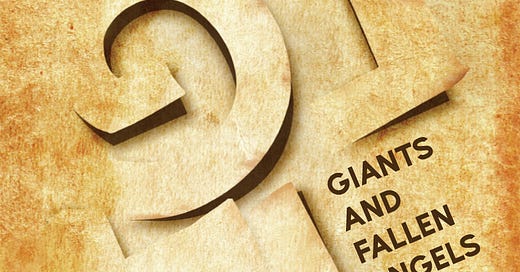A new chareidi book promotes the Torah as utilizing myth
Nephilim: Giants and Fallen Angels According to Chazal
I haven’t had a free moment for some time, and I really want to finish my series.
I will spoiler it here though, so I can discuss this new book.
My thesis is that the Torah was not written as a history book. Instead, it utilizes the tropes of ancient myths to deliver information to its original ANE audience. It was not a lie, because the original audience would have recognized those tropes and instantly recognized from where they came. We, living many thousands of years later and unfamiliar of the genre of myth, mistakenly interpret it literally, causing issues with modern science.
This avoids the issue of retrojection apologetics, where people try to fit the Torah into saying science which had not existed. It also avoids the issue that Torah was saying something that would not have been understood by its original receivers.
The Torah is not primitive, directed to primitive people. This is why I really dislike the way R Natan Slifkin puts it “The Torah packaged it for their worldview”. Rather the Torah assumed its early audience was extremely educated: Familiar with the stories of Baal, Asherah, Gilgamesh and other ancient myths and tropes, and with the legal codes of Hammarabi. The Torah cleverly rewrites and subverts those myths and rejects those moral messaging.
This happens all the time intrabiblically (There’s a great book “Subversive Sequels in the Bible” that demonstrates this), when Tanakh uses and rewrites earlier texts. Rabbi David Fohrman calls this intertextual wordplay the worlds first hypertext. This is pretty much agreed to by all scholars, and by chazal as well. What I am doing is extending this fact outside of Tanakh and saying Tanakh also subverts and rewrites stories found outside of Tanakh. This especially happens in the beginning of Bereshis, where Enuma Elish is referenced and rewritten in Genesis 1, Ashera in the story of Etz Hadaas, and Gilgamesh by Noach. This subtext is overlayed with the real story, so their very well may have been a real local flood and a man called Adam. But how accurate each detail is we will never know, nor are we intended to, because that is not how the Torah works. The Torah is a monotheism manual, not a science book. Hashem wanted us to figure out science on our own, and originally morality and monotheism as well. But when He realized Mankind was not coming to that conclusion independently, with the exception of one man called Abraham, he interfered and created a nation called Israel to teach the world about the One God. But science and agriculture man figured out just fine, and Hashem had no need to teach it.
What I was always bothered by was the fact that while it is relatively obvious to those familiar with the myth material that the Torah is utilizing them, why don’t Chazal mention them?
This is where I always suspected that Chazal were aware, but minimized it because it outlived its purpose, but I had no real proof to that, other than the fact that Chazal banned seforim chitzonim, and I always figured it was for that reason.
Luckily, there is a new book out by a Chareidi press, no less, that uses the story of the Fallen Angels (the most obvious case of myth in the Torah) and examines how this is clearly a myth meant to teach us moral lessons in the context of Noach, that Chazal both simultaneously held of the fallen angels myth and suppressed it, and examines Chazal’s and the meforshim’s views on this fascinating story. It also explains that myth does not mean bubba maysa but is the way the ancient world communicated lessons. I highly recommend this book. There are almost no secular sources used.
Buy it here: https://a.co/d/gJde3aR (I may get a small commission).
See the table of contents and haskamos here: https://mosaicapress.com/product/nephilim-giants-and-fallen-angels/?srsltid=AfmBOopm1KKm0T1gsoOaCJXnBPBVSIPyhChfc7dfgZ1GI1E66RBNaMjg
Another great secular book that examines myth is called When They Severed Earth From Sky. The book’s thesis is that myths were intentionally created to preserve material orally, as exciting stories would be remembered and retold. Thus, the ancient societies knew it largely wasn’t factually true, but the message was. With the spread of writing, myth largely became extinct, and we nowadays are unfamiliar with the genre at all. Buy it here: https://a.co/d/hODLdag





Your conspiracy theory that Chazal purposely withheld from us that the Torah is a book of fairytales, is something I would expect from Alexander Hool, not from you.
On Tisha bav night I noticed lots of parallels between Eicha and Iyov
compare
דָּרַךְ קַשְׁתּוֹ וַיַּצִּיבֵנִי כַּמַּטָּרָא לַחֵץ
to
וְאָחַ֣ז בְּ֭עׇרְפִּי וַֽיְפַצְפְּצֵ֑נִי וַיְקִימֵ֥נִי לֹ֝֗ו לְמַטָּרָֽה׃
and
הֵבִיא בְּכִלְיֹתָי בְּנֵי אַשְׁפָּתוֹ
to
יָסֹבּוּ עָלַי רַבָּיו יְפַלַּח כִּלְיוֹתַי
and
הִשְׂבִּיעַנִי בַמְּרוֹרִים הִרְוַנִי לַעֲנָה
to
לֹא־יִתְּנֵנִי הָשֵׁב רוּחִי כִּי יַשְׂבִּעַנִי מַמְּרֹרִים
and
וַיַּגְרֵס בֶּחָצָץ שִׁנָּי הִכְפִּישַׁנִי בָּאֵפֶר
to
וַיִּֽקַּֽח־לֹ֣ו חֶ֔רֶשׂ לְהִתְגָּרֵ֖ד בֹּ֑ו וְה֖וּא יֹשֵׁ֥ב בְּתֹוךְ־הָאֵֽפֶר
and
חֶלְקִי יְהֹוָה אָמְרָה נַפְשִׁי עַל־כֵּן אוֹחִיל לוֹ
to
הֵ֣ן יִ֭קְטְלֵנִי (לא) [לֹ֣ו] אֲיַחֵ֑ל
and
הָיִיתִי שְּׂחֹק לְכׇל־עַמִּי
to
שְׂחֹ֤ק לְרֵעֵ֨הוּ ׀ אֶֽהְיֶ֗ה
and
גָּדַר דְּרָכַי בְּגָזִית נְתִיבֹתַי עִוָּה
to
אׇרְחִ֣י גָ֭דַר וְלֹ֣א אֶעֱבֹ֑ור וְעַ֥ל נְ֝תִיבֹותַ֗י חֹ֣שֶׁךְ יָשִֽׂים׃
So it must be that Eicha is using, rewriting, and subverting Iyov (or vice versa).